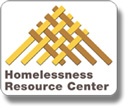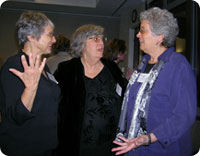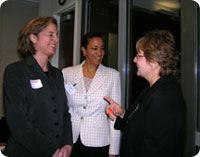 |
 |
By Rebecca A. Clay
Web 2.0. It’s the latest computer buzzword. But
how can it be of use to service providers
who work with people who are homeless? |
Young and well educated, but overworked
and underpaid, these providers operate
in programs with few resources for
expensive computer hardware.
But when they go home at night, they
log on to their personal computers
and visit Facebook and MySpace to relax
and connect. Tech-savvy and computer
literate, they are ripe for SAMHSA’s
Homelessness Resource Center (HRC),
a virtual community located at www.homeless.samhsa.gov.
Using innovative Web 2.0 technology
(see What Is
Web 2.0?), SAMHSA’s
HRC gives service providers support—ways
to share ideas, get advice, or just
chat.
 “The site also offers information
designed to help service providers
avoid burnout and continue being as
effective as possible in both their
professional and personal lives,” said
Deborah Stone, Ph.D., SAMHSA’s
Project Officer for HRC and a social
science analyst in the Homeless and
Co-Occurring Disorders Branch at SAMHSA’s
Center for Mental Health Services (CMHS). “A
provider in San Francisco may not know
about a program in Boston, although
both cities face similar challenges.
Now, they can share ideas and solutions.” “The site also offers information
designed to help service providers
avoid burnout and continue being as
effective as possible in both their
professional and personal lives,” said
Deborah Stone, Ph.D., SAMHSA’s
Project Officer for HRC and a social
science analyst in the Homeless and
Co-Occurring Disorders Branch at SAMHSA’s
Center for Mental Health Services (CMHS). “A
provider in San Francisco may not know
about a program in Boston, although
both cities face similar challenges.
Now, they can share ideas and solutions.”
According to CMHS Director A. Kathryn
Power, M.Ed., the new Web site exemplifies
the Agency’s commitment to tackling
the problem of homelessness.
“Homelessness is an ongoing
challenge to our creativity and to
our funding limitations,” Ms.
Power said. “SAMHSA continues
to make the issue of homelessness—especially
among individuals with mental illness
and co-occurring substance abuse disorders—a
top priority.”
Back
to Top
More Than Documents
The HRC is guided by an Advisory Steering
Committee, which comprises expert providers,
researchers, and consumers, that helps
shape the Web site’s continued
development.
“People were invited to be members
of the HRC Advisory Steering Committee
because of the leadership roles they
play. They bring different perspectives
to the field of serving and housing
people who are or have been homeless,” said
Committee Co-Chair Fred C. Osher, M.D.,
a staff psychiatrist at Health Care
for the Homeless in Baltimore. “These
folks help connect SAMHSA’s Homelessness
Resource Center to emerging trends
and the needs of practitioners.”
Most resource centers are simply clearinghouses
where users can download documents.
But after logging in at the HRC, registered
users can create profiles, comment
on articles, and interact with each
other, just as they would on Facebook
or MySpace.
Social networking features are easy
to use, emphasized HRC Web site designer
Matthew Amsden. “If you’ve
ever created a profile on Facebook,
added a comment on Amazon, or rated
a movie on Netflix,” he said, “the
site’s features will be familiar.
We haven’t really created anything
unique, just applied it in a unique
way.”
Within the overall “community,” there
are areas for specific groups, such
as grantees who are part of SAMHSA’s
Projects for Assistance in Transition
from Homelessness (PATH) or those involved
in the Services in Supportive Housing
Initiative (see Homelessness
Initiatives).
The goal is for these online communities
to become offline communities as well. “We
hope that individuals will meet in
person,” said Dr. Stone. “Small
groups across the country, without
any input from the HRC or SAMHSA, are
encouraged to get together to talk
about homelessness-related issues.”
Back
to Top
One-Stop Shopping
The goal is to offer one-stop shopping
to anyone interested in homelessness-related
resources—to organizations within
the private sector as well as in the
Government’s public sector.
The new site fulfills a clearinghouse’s
traditional mission of providing a
wealth of information, including research
materials. An area called “Library” features
about 4,000 recent articles, research
papers, and other resources on homelessness.
For users’ convenience, these
materials are grouped into categories.
Each link includes an abstract that
lets users know what’s there.
“That information will be especially
helpful given the new challenges the
field is facing,” said Fran Randolph,
Dr.P.H., M.P.H., Director of the Division
of Services and Systems Improvement
at CMHS. “We still focus on people
with serious mental illness, but we
have more and more people who are going
to be entering the homeless world who
don’t fit the typical profile,” she
explained.
As examples, Dr. Randolph
cited veterans returning from Iraq
and Afghanistan and also families who
have recently lost their homes to foreclosure.
Although the HRC Web site features
just as much information as a traditional
clearinghouse, it looks very different.
The site is very graphics-intensive,
designed to appeal to the technologically
sophisticated young people who are
the site’s primary audience.
In addition, pages are organized around
specific topics: outreach, consumer
involvement, motivational interviewing,
youth, trauma, health, and housing.
Back
to Top
 |
 |
 |
| |
|
|
| The
Homelessness Resource Center’s
Advisory Steering Committee had
a chance for a before-launch “peek” at
the HRC’s new Web site in
May. Members present included (left
to right) Marti Knisley, Director,
Community Support Initiative, Technical
Assistance Collaborative; Deborah
Stone, Project Officer, SAMHSA’s
HRC, funded by the Agency’s
Center for Mental Health Services
(CMHS); and Carol Wilkins, Director,
Intergovernmental Policy Corporation
for Supportive Housing. Photo
by Meredith Hogan Pond |
|
Mary
Ellen Hombs, Deputy Director, U.S.
Interagency Council on Homelessness;
Elizabeth Lopez, Branch Chief,
Homeless Programs and Co-Occurring
Branch at SAMHSA’s
CMHS; and Fran Randolph, Division
Director at CMHS. Photo by Meredith
Hogan Pond |
See Also-Homelessness
Services: Web 2.0 Connects Providers Online
See
Also—Article: Part 2 »
What
Is Web 2.0? »
Homelessness Initiatives »
Next
Article »
Back
to Top
|



 “The site also offers information
designed to help service providers
avoid burnout and continue being as
effective as possible in both their
professional and personal lives,” said
Deborah Stone, Ph.D., SAMHSA’s
Project Officer for HRC and a social
science analyst in the Homeless and
Co-Occurring Disorders Branch at SAMHSA’s
Center for Mental Health Services (CMHS). “A
provider in San Francisco may not know
about a program in Boston, although
both cities face similar challenges.
Now, they can share ideas and solutions.”
“The site also offers information
designed to help service providers
avoid burnout and continue being as
effective as possible in both their
professional and personal lives,” said
Deborah Stone, Ph.D., SAMHSA’s
Project Officer for HRC and a social
science analyst in the Homeless and
Co-Occurring Disorders Branch at SAMHSA’s
Center for Mental Health Services (CMHS). “A
provider in San Francisco may not know
about a program in Boston, although
both cities face similar challenges.
Now, they can share ideas and solutions.” 

